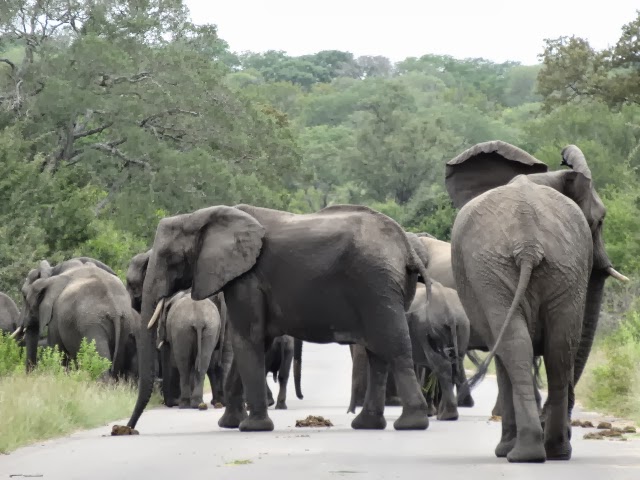 |
| Our first photo of an elephant we spotted on Tuesday in Kruger National Park. |
“Sighting of the Day in the Bush”
 |
| Often, we see francolins wandering in the bush. |
We don’t want our worldwide readers to tire of wildlife photos. Over time, we’ll include other aspects of life in South Africa, but we’re like little kids in a candy shop for now…we can’t get enough.
Each time a visitor stops by, whether a frequent guest or someone new, we jump to attention (quietly, of course) to grab the yellow container of pellets and the camera.
 |
| We hoped to see an entire herd, but even one is a treasure when one can enter the park for the whole of a day and never see anything other than impalas and warthogs. |
There’s no doubt in our minds that many of the wild animals are getting more comfortable with us, even in many cases, learning the sound of our voices. Gently and lovingly, we speak to them. In that way, they may be no different than engaging with household or farm animals that freely respond to human voices.
Most of the wildlife in Marloth Park are comfortable around one another, with few predators in the park except for an occasional visiting lion. He manages to enter from under the fence at the Crocodile River. Legend has it, that warthogs with their ability to dig with their snouts, leave open areas under the fences where the lions can enter.
 |
| We were very far from this elephant and were lucky to have seen it near the river. |
As we spend hours each day observing animal behavior, grazing habits, and their interaction with one another, we are more and more amazed by the intellect of many of the wild animals surrounding us each day.
Entering Kruger National Park is an entirely different scenario than being in Marloth Park. Although the animals in Marloth are on their foraging for food, in Kruger, they are “food” for many carnivorous animals, including lions, leopards, cheetah, hyenas, and others.
 |
| It’s a bit of scratching against a tree branch… |
In these cases, few animals are safe from becoming today’s breakfast, lunch, or dinner, perhaps except for elephants and crocodiles. We’ve seen videos of lions taking down Cape Buffalo, giraffe, and baby elephants but seldom a full-grown adult elephant.
An animal’s perception of the size of other animals is mind-boggling. It tells us so much about their ability to think and make decisions, yet many have refused to believe their abilities, referring to it as instinct.
 |
| This is most likely a lone male elephant, as explained here: “Male or bull elephants have very different social needs than the females. In the wild, males leave or are driven out of the family group as they approach sexual maturity. Males spend as much as 95% of their lives alone or in loose association with other bulls.” |
But is it instinct when a lion checks out a full-grown elephant and asks, “Do I want to “go there?” In our perception, however naive it may be from such a short period of observation, they do have the capability of thinking.
A few minutes ago, I stopped to greet two female kudus and three youngsters. Feeding one of them from the palm of my hand while holding the small yellow pellet container in the other hand, she nudged my hand for more, even sticking her nose in the yellow container, all the while making eye contact with me.
 |
| Soon, he began to wander toward the river. |
There’s something much more profound and meaningful than pure instinct in the above scenario. And, when we watched this lone elephant standing near the river deciding whether or not to enter, we can only surmise that the thought process is much more profound than we may expect.
Are we humans so superior to the “wild things” that we assume we’re the only creatures on earth that can think, reason, and decide?
 |
| The exquisite massive beast stood staring at the river and soon wandered off after deciding not to drink or enter. |
In our short period in Kruger on Tuesday, our hearts were filled by the wonder of what remains of magnificent animals in the wild in Africa, and we can only pray for a resolution for the senseless slaughter of these treasures of nature for their horns, tusks, hides, and meat. There’s no easy answer.
 |
| We shot this photo during a self-drive in Kruger in January 2014. We’ll always remain grateful for this sighting and may never be so lucky again. Click here for that post. |
In sighting elephants in Kruger, it’s tricky. One could drive for days and never experience a single sighting. Then, suddenly there are 30 or more on the road as we blissfully encountered four years ago, as shown in the above photo, from that post.
Having had such safari luck on Tuesday inspires us all the more to return to Kruger many more times, while during the periods in between, we revel in the surroundings in our very yard in Marloth Park.
 |
| We observed, hoping to see him drink or enter the river. |
Today, we’re off to shop in Komatipoort, although at this point, after many visitors this morning, it’s difficult to leave…
Photo from one year ago today, March 1, 2017:
 |
| Sydney Harbour Bridge. It was one year ago today we boarded a cruise from Sydney. For more details, please click here. |
